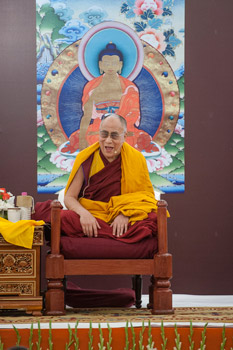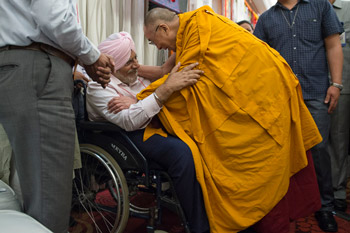His Holiness the Dalai Lama Gives Teachings in the Indian Capital
New Delhi, India, 21 March 2014 - On behalf of the Foundation for Universal Responsibility, Rajiv Mehrotra welcomed His Holiness the Dalai Lama to a gathering of about 320 people in New Delhi today. He said they were blessed and honoured that he was with them again and dedicated any merit or insight that might arise as a result to the benefit of all sentient beings. In his response, His Holiness greeted everybody, saying it was good to see so many old friends. Asking how many were there for the first time, the raised hands indicated about two-thirds. He began:
“I usually describe myself as just a Buddhist monk and as a human being, one of the 7 billion alive today. There are no differences between us; emotionally, physically and mentally we are all the same. We all want to lead a happy life. In order to do that we need to develop peace of mind, this in turn requires knowledge of the mind and emotions. This is what we are here today to discuss.” 
| His Holiness the Dalai Lama speaking during his teaching in New Delhi, India on March 21, 2014. Photo/Tenzin Choejor/OHHDL
|
He spoke of his commitment to promoting inner peace by integrating secular ethics into our lives without necessarily depending on faith. He added, however, that faith, be it in God or like Jains and Buddhists in the law of causality, can be useful in developing peace of mind. He clarified that within Buddhism, the Pali tradition represents the foundation, on which the Sanskrit tradition with its emphasis on infinite altruism and deeper understanding of reality is based.
Before inviting everyone to join in reciting the ‘Praise to the 17 Masters of Nalanda’, he explained that he had composed it to honour not only the original eight Indian masters included among the Six Ornaments and the Two Supreme Ones - Nagarjuna, Aryadeva, Asanga, Vasubandhu, Dignaga, Dharmakirti, Gunaprabha, and Shakyaprabha, but also Buddhapalita, Bhavaviveka, Chandrakirti, Shantideva, Shantarakshita, Kamalashila, Vimuktisena, Haribadra and Atisha. He said he regards these masters as professors of Nalanda University, whose works have had great influence on the Tibetan Buddhist tradition. Their rigorous approach is exemplified by Nagarjuna and Chandrakirti who examined the Buddha’s words and noted that where they contradicted reason they should not be taken literally. He feels this is a scientific approach.
Dialogue with modern scientists over the last thirty years has taught Tibetan Buddhists a great deal about the material world, which has been of immense benefit. However, it has also revealed that modern psychology still has only a very basic understanding of the mind. He noted:
“As human beings we need to make an effort to promote awareness that the ultimate source of a happy life is within ourselves. Meanwhile, scientists have observed that a happy mind is essential if we are to enjoy physical health. The affection we receive as infants from our mothers equips us to develop the warm-heartedness that is the basis of this.”
 | His Holiness the Dalai Lama enjoying a moment of laughter during his teaching in New Delhi, India on March 21, 2014. Photo/Tenzin Choejor/OHHDL
|
Pointing out that the climate change, environmental problems and the global economy all indicate our need to work together, His Holiness stressed the importance of focussing on the whole of humanity. This is why our education systems must include a sense of ethics. In order to retain a universal appeal, such ethics need to have a secular basis. He cited the example of India’s secular constitution, which far from dismissing religion expresses respect for all religions and the right of those who choose to have none. This secular approach reflects the religious harmony that has flourished in India for thousands of years.
“All religious traditions foster a sense of love and compassion and because greed and desire can obstruct it, they also advise contentment. The idea of being created by God means that individuals possess a spark of God within them. This is a powerful concept that resembles the Buddhist explanation of Buddha nature. If you ask the purpose of such different philosophical ideas, it is to foster a sense of love and compassion.”
His Holiness repeated that if we choose to engage in religious practice, it is important to do so sincerely.
Following a short break for tea, he announced his intention to explain a verse that is sometimes referred to as the ‘essence of dependent origination.’ It comes from the Vinaya, is found in both the Pali and Sanskrit traditions and is often written on the walls of temples:
Ye dharma hetuprabhava hetum tesham tathagata hyavadat tesham cha yo nirodha evam vadi mahashramana
Of those things that arise from causes,
The Tathagata has taught those causes,
And also what their cessation is:
This is the doctrine of the Great Recluse.
The cessation of causes here refers to the cessation of the causes of suffering.
“What we seek is happiness and yet what we encounter is suffering because we are under the sway of ignorance. Consequently, what we need is insight into the true nature of things. The Buddha revealed the possibility of attaining a state free from suffering. This is consistent with the teaching of the Four Noble Truths and the basic Buddhist concept of the law of causality or cause and effect. Whether our actions are positive or negative depends entirely on our motivation. Suffering results from our being motivated by disturbing emotions such as anger, hatred and attachment that are very much related to ignorance.”
His Holiness talked of his meeting with the experienced American psychologist Aaron Beck who told him that when we are angry, the object of our anger seems entirely negative and yet that negativity is 90% mental projection. This accords with what Nagarjuna taught long ago.

| His Holiness the Dalai Lama greeting a member of the audience attending his teaching in New Delhi, India on March 21, 2014. Photo/Tenzin Choejor/OHHDL
|
His Holiness remarked that disturbing emotions are so called because they disturb our peace of mind and lead to harmful action. The Tibetan term has the sense of something that makes us unhappy, that brings trouble to ourselves and others. The ultimate cause of suffering is ignorance that is a misconception of reality. However, any misconception can be countered by knowledge no matter how strong it may seem, because knowledge is based on reality, while ignorance has no basis at all. As we become more familiar with reality, ignorance becomes thinner until it is eliminated altogether. The mind is clear and neutral so when combined with compassion it becomes positive, but when combined with anger or attachment it becomes negative.
When it comes to training the mind, His Holiness explained, once you reach a certain level there is no need for renewed effort, because of its continuity. The possibility of the cessation of suffering accords with the Third Noble Truth, the path to which involves wisdom derived from a threefold awareness involving hearing, reflection and meditation. To deepen understanding we need single-pointed concentration, for which mindfulness is important, and that in turn depends on morality. So, morality, concentration and wisdom are the three important factors here.
According to the Sanskrit tradition, the Second Turning of the Wheel of Dharma concerns the teaching of the Perfection of Wisdom. This consists of 20 volumes including the Perfection of Wisdom in 100,000 lines, 25,000 lines, 18,000 lines, 8,000 lines, 2,500 lines, 700 lines, 500 lines, 300 lines and 25 lines. The last two, the texts in 300 and 25 lines, the ‘Diamond Cutter Sutra’ and the ‘Heart Sutra’ are the most widely known. The ‘Heart Sutra’ contains a dharani, ‘Gate, Gate, Paragate, Parasamgate, Bodhi svaha’ or ‘Go, Go, Go beyond, Go completely beyond, lay the foundation of enlightenment.’
His Holiness explained how this represents the path of spiritual development. The first two words ‘Go, Go - Gate, Gate’ refer to the paths of accumulation and preparation respectively. ‘Go beyond - paragate’ refers to the path of seeing on which emptiness is seen directly without duality. ‘Go completely beyond - parasamgate’ refers to the path of meditation, while ‘lay the foundation of enlightenment - bodhi svaha’ refers to the path of no more learning. Enlightenment here could refer to the attainment of the paths of Hearers or Solitary Realizers or, motivated by altruism, to the enlightenment of a Buddha.
Common to the basic and greater vehicles are the 37 factors of enlightenment which include the Four Foundations of Mindfulness, the Four Right Efforts and the Four Bases of Power that relate to the path of accumulation; the Five Faculties and Five Strengths that relate to the path of preparation; the Seven Factors of Enlightenment that relate to the path of seeing; and the Eightfold Noble Path that relates to the path of meditation. Again, His Holiness explained that within the Eightfold Noble Path, right livelihood, right action and right speech concern morality; right mindfulness and right concentration concern concentration, while right view and right thought concern wisdom. He said that to attain the path of a noble being, you prepare from the beginning to integrate these practices in order to reach the path of seeing. This involves practising with honesty and contentment.
He reiterated that enlightenment can mean mere liberation from disturbing emotions or the great enlightenment of Buddhahood in which disturbing emotions are eliminated along with their imprints.
The basis of the Four Noble Truths is dependent origination. This can be interpreted as causality in common with all Buddhist paths or as referring to existence as mere designation, which is found only in the Madhyamaka explanation. Existence in dependence on other factors and the implied lack of independent existence resembles the account of Quantum Physics today, but was first described 2000 years ago by Nagarjuna.
His Holiness concluded the day’s talk, saying:
“Now it’s time for tea, a shower and sleep, then up again at 3am for analytical meditation, reflecting on the nature of the mind. Although everything appears to have independent existence, remembering that nothing exists that way produces an experience of things being like an illusion, which shakes up the basis of the disturbing emotions.”
His Holiness will continue to teach tomorrow.  http://www.dalailama.com/
|